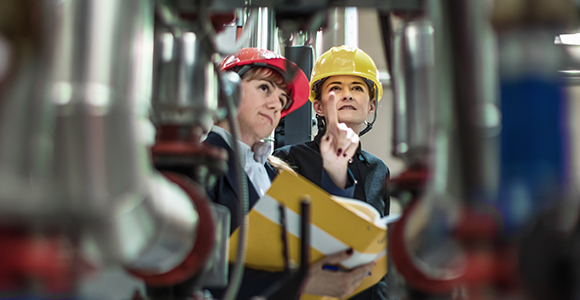The Road to 2050: What is a 'just transition'?
December 7, 2021
-
4 minutes

As we continue to assess how closely global leaders are sticking to their goals of reaching net-zero carbon emissions by 2050, one of the challenges they face is maintaining fairness and equity within the transition itself. As part of our ESG Conference The Road to 2050: Navigating the ESG Landscape, one panel of industry leaders looked at what it means to foster a 'just transition' and the support required from both the public and private sector to sustain one.
Richard Kelly, Head of Global Strategy at TD Securities, spoke to Alban de Faÿ, Head of Fixed Income, ESG Investing at Amundi, and Isabelle Laurant, Deputy Treasurer and Head of Funding at EBRD, and Francis Fong, Managing Director of ESG Research at TD Economics, to examine how a just transition should be defined, the role of government and regulatory bodies, and incentivizing support.
First, what is a just transition? Through our discussion, we concluded that a just transition is ensuring the benefits of a green economy are shared widely and equitably. This includes financing interventions that support a green transition, protecting vulnerable countries, regions, and people from falling behind, and assisting industries who are reliant on fossil fuels to access new opportunities.
Key takeaways from our discussion include:
Richard Kelly, Head of Global Strategy at TD Securities, spoke to Alban de Faÿ, Head of Fixed Income, ESG Investing at Amundi, and Isabelle Laurant, Deputy Treasurer and Head of Funding at EBRD, and Francis Fong, Managing Director of ESG Research at TD Economics, to examine how a just transition should be defined, the role of government and regulatory bodies, and incentivizing support.
First, what is a just transition? Through our discussion, we concluded that a just transition is ensuring the benefits of a green economy are shared widely and equitably. This includes financing interventions that support a green transition, protecting vulnerable countries, regions, and people from falling behind, and assisting industries who are reliant on fossil fuels to access new opportunities.
Key takeaways from our discussion include:
How is the Canadian government adapting policy to support a 'just transition' within the energy industry?
- A just transition is an emerging area of the Canadian policy landscape, still in its infancy.
- Not knowing the exact path, or the exact investments needed to provide a just transition creates roadblocks in designing and implementing the right policies. The Canadian government, like many other governments, is hesitant to commit to implementing policies without a clear plan mapped out first.
- The regionalized dependency on fossil fuels within Canada further complicates the matter. There is no one-size-fits-all strategy to help these communities transition, from rural to Indigenous.
- Canada's current climate policy landscape is a combination of carbon pricing regulations and co-investing to incentivize and scale up technologies, infrastructure and supply chains that might not otherwise develop on their own. Examples include stepping up electric vehicle manufacturing, green steel, and early talks around building a hydrogen supply chain.
Explore more from our The Road to 2050: Navigating the ESG Landscape series. Read Understanding the link between investing and climate strategies
What incentives do companies, governments and markets offer to increase investments for a 'just transition' and how are they kept accountable?
- There is a shift to a broader, contextualized focus -- especially in the hard-to-abate sectors -- analyzing how projects fit into a holistic, integrated strategy to reach Paris alignment.
- The EU has been a strong proponent in the push to incentivize companies. Creating regulatory reporting requirements on investments encourage investors to fund projects that evolve and contribute to the aims of a just transition.
- Multilateral Development Banks (MDB) have come together to develop common principals on supporting a just transition. MDBs recognize the need to articulate and contribute to the aims of a just transition consistently, credibly, and transparently while also realizing that every company has a different mandate, focus and degree of flexibility and climate strategy.
How will central banks evolve in the regulatory space in the support of a just transition?
- There is need for a "regime shift" in how traditional financial institutions approach risk management and learn to incorporate transition risk into their framework and methodologies.
- Adoption of protective measures that address climate and support an orderly transition to a low carbon economy. There is acknowledgement that a disorderly transition poses a major risk to their central mandates.
- Further stress testing. It pushes financial institutions to better consider their physical and transitional risks in their lending portfolios.
What does a global approach to just transition look like?
- While European governments are demonstrating strong leadership with innovative policy tools addressing climate change and social issues, the political landscape in North America is still catching up.
- There appears to be more common ground within the global investment community. There is a stronger push for investors to incorporate and consider ESG into investment decisions, which drive the kind of innovation and change companies need to implement to achieve the "below 2 degrees" benchmark.
What needs to happen next?
While the importance of a just transition is becoming clearer to the private sector, additional awareness, support and incentivization are still required to truly facilitate a transition globally. Additional focus and pressure from the public sector would drive increased support across industries and sectors. While mapping this out still requires further complex assessment and study before we start seeing more regulatory support, governments appear to be aware of the critical need to support a just transition and understand the impact a disorderly transition will have on their larger net-zero carbon goals.
Learn more about our environmental, social and governance strategies from our Sustainable Finance & Corporate Transitions team




